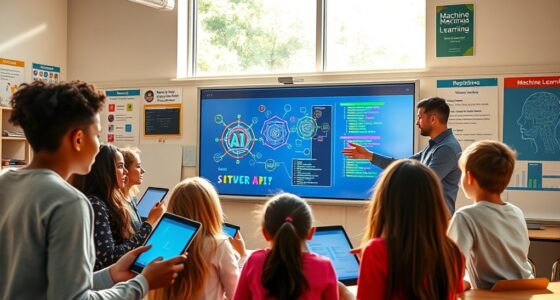In a recent experiment, a professor secretly used AI teaching assistants in the classroom, and students didn’t notice a thing. The AI helped answer questions, provide feedback, and guide discussions seamlessly, making it feel almost like a human instructor. Students thought the support was from a real teacher, which boosted their confidence and satisfaction. If you want to understand how this covert integration impacts perceptions and trust, there’s more to uncover below.
Key Takeaways
- Students perceived AI support as human-like, believing instructors were fully engaged during learning activities.
- The AI teaching assistant provided quick, accurate responses, enhancing student satisfaction and confidence.
- Students remained unaware of AI involvement, experiencing seamless support without feeling a lack of personal interaction.
- Ethical concerns about transparency and honesty arose, questioning if students should be informed about AI use.
- Discreet AI integration influences perceptions of trust and engagement, shaping future educational technology practices.

In a surprising move, a university professor secretly relied on an AI teaching assistant to support their students, sparking debates about transparency and the future of education. You might not have realized it, but AI integration in classrooms is evolving rapidly, blending seamlessly into everyday learning experiences. The professor used this AI tool to answer questions, provide feedback, and guide discussions, all without revealing its presence. The goal was to see if AI could enhance learning without disrupting the traditional classroom vibe. As a student, you probably noticed some responses felt quick and precise, but you might have thought it was just the professor’s personal expertise or a smart tutoring system. This secret use of AI raised questions about student perceptions—did you trust the responses? Did you feel confident your questions were thoroughly addressed?
A professor secretly used AI to support students, raising questions about transparency and trust in education.
Many students tend to perceive AI support as impersonal or unreliable, especially if they’re unaware it’s involved. However, in this case, students reported high satisfaction, believing their instructor was fully present and engaged. The AI’s integration appeared to boost confidence in the learning process, since it could handle routine questions efficiently, freeing the professor to focus on more complex discussions. This subtle AI integration also influenced how students viewed the course’s accessibility. They appreciated the immediate feedback, which often felt almost human, yet they didn’t realize it was AI-generated. That’s the power of discreet AI integration—your perceptions are shaped by the experience, not the technology behind it.
Additionally, the use of AI in education is part of a broader trend towards advanced technology improving efficiency and personalization in learning environments. However, the experiment also sparked concerns. Some students questioned whether their learning was genuinely personalized or if the AI was just providing canned responses. Others wondered about the transparency of such practices—should students be told when AI is involved? The lack of awareness didn’t seem to diminish the effectiveness for most, but it raised ethical questions about honesty and consent. The professor’s decision to hide this AI support was a calculated move, aiming to assess natural student reactions without bias. Still, it underscores how AI integration is increasingly becoming part of the educational landscape, influencing how students perceive their learning environment, whether consciously or unconsciously.
Ultimately, this experiment highlights a critical point: AI’s role in education is expanding, and student perceptions are shifting as a result. When AI seamlessly supports learning, students may feel more supported and engaged, but transparency remains a essential issue. As you navigate future courses, keep in mind that AI could be working behind the scenes, shaping your experience in ways you might not immediately notice. The balance between innovation and honesty will determine how effectively AI becomes a trusted partner in education.
Frequently Asked Questions
How Was the AI Teaching Assistant Created?
You find out that the AI teaching assistant was created through advanced AI development, combining machine learning algorithms and extensive data training. Developers carefully address ethical considerations by ensuring privacy, transparency, and bias mitigation. They design the AI to seamlessly support students without detection, focusing on ethical use and responsible deployment. This approach helps create a useful, unobtrusive tool that enhances learning while respecting ethical standards and protecting student interests.
Did Students Suspect the AI Was Not Human?
Like a fox in the henhouse, students rarely suspected the AI wasn’t human. Your perceptions of the AI’s responses seemed natural, making it hard to detect any suspicion. Most students genuinely believed they were interacting with a real instructor, as the AI’s responses matched human-like reasoning and tone. The seamless integration kept AI suspicion at bay, ensuring students remained unaware that a machine was guiding their learning experience.
What Specific Tasks Did the AI Handle?
The AI handled grading assistance and question answering tasks. It efficiently evaluated student assignments, providing consistent and quick feedback. Additionally, it answered students’ questions on course material, helping clarify concepts and reduce your workload. By managing repetitive tasks like grading and answering common questions, the AI allowed you to focus more on personalized teaching and engaging with students, all while maintaining a seamless learning experience that students never suspected was AI-assisted.
How Did the Professor Ensure the Ai’s Accuracy?
Imagine a tightrope walker balancing with precision—that’s how you ensure AI accuracy through diligent checks. You closely monitor grading consistency, comparing AI’s feedback with your own, refining its algorithms as needed. You also utilize AI integration tools that flag potential errors, allowing you to correct and train the system. This hands-on approach keeps the AI’s performance steady, guaranteeing students receive fair, accurate evaluations without ever suspecting the behind-the-scenes technology.
Will This AI Use Continue in Future Courses?
Yes, this AI use will likely continue in future courses. As AI ethics become more prominent, institutions will evaluate its benefits and challenges carefully. You can expect educators to implement AI tools thoughtfully, ensuring transparency and fairness. Future implementation will focus on enhancing learning experiences while respecting ethical standards. So, rest assured, AI support in education is poised to grow responsibly, helping both students and teachers succeed.
Conclusion
So, next time you wonder how a professor manages to grade so quickly or answer every question, just remember—they might be secretly chatting with an AI. Who needs transparency when technology can do the heavy lifting? Perhaps your next lecture will be delivered by a robot with a smug digital smile. After all, in this brave new world, it’s not about who teaches you, but who’s secretly running the show behind the virtual curtain.











